The Keys to FEC Success in Asia

At the Neobio family entertainment center (FEC) in Shanghai, a young girl in a blue princess dress slides through a transparent acrylic tunnel into a ball pit. She waves to her mom, who relaxes while enjoying a cup of coffee with a friend. Seated on plush chairs and gilded benches, they are surrounded by pastel colors and imaginative balloon canopies created by Li Xiang, head of the architectural design firm X+Living that has developed a reputation for conceiving “otherworldly interiors.”
“Neobio is a different model,” explains Beth Chang, executive director of economics at AECOM, who recently led a survey of the FEC landscape in China. “The number of mechanical rides is generally limited, while ample space is available for parents to relax and take photographs.”
At some Chinese FECs, parents or grandparents may choose to sit on benches outside the attraction, staring at their phones, while the children play inside. Not at Neobio, a high-end niche chain that charges as much as 398 Chinese yuan (CNY)—about $62—per entry for a parent and one child. Since launching in 2016, Neobio has expanded to six major Chinese cities.
“They provide first-rate service and very nice fit-outs,” says Chang. “Neobio’s strong ‘Instagram-worthy’ design, high-quality entertainment offerings, and edutainment elements make them popular among social media-savvy parents seeking to spend quality time with their children and share stories of their experience on WeChat Moments.”
Fast-Growing Marketplace Pauses
FECs are a relatively new phenomena in China. Unlike the United States, where FECs trace their history back to the 1950s, FECs began to enjoy popularity with Chinese consumers at the beginning of the millennia. Today, AECOM estimates there are as many as 5,000 FECs in the country, largely targeting the preschool market, with an estimated market value of CNY 40-50 billion. Other consultancies place the market value as high as CNY 150 billion, though it is possible these estimates include midway attractions.
The last year has been a difficult one for the industry, though.
“I think the pandemic has hit the FEC market much harder than the outdoor theme park market,” says Chang. “You have little kids, with saliva on their hands, touching anything and everything. Chinese parents are still very hesitant to send their kids, especially younger ones, to indoor FECs,” she adds.
While Chang expects the market to gather some steam in the year ahead, AECOM is not forecasting a full recovery for FECs in China until 2023.
The situation is different in other Asian markets. In Singapore, for example, where most citizens have not been able to leave the island in more than a year due to international travel restrictions, the demand for domestic entertainment, including indoor FECs, has rallied, according to industry participants. However, social distancing regulations still limit attendance.

A Revolving Door
More so than other countries in the region, national FEC chains dominate the market in China, which start in big cities, then branch out.
One of the most famous brands is Yuyuto, which grew to more than 300 self-owned and franchised outlets in just a few years. The expansion proved too fast and was done with too little capital expenditure, though. The company sold many of its stores to the maternity-focused e-commerce platform Mia.com two years ago and is currently undergoing bankruptcy. Yuyuto’s experience, with a focus on franchising and limited capital expenditure, is indicative of the approach and problems faced by many FEC operators in the country.
“Unfortunately, many franchisees get into the market with the mentality that this is quick money,” explains Chang. “It’s very low investment. They expect to recoup their capital within the first year and do not make significant reinvestments.”
Consumer preferences play into this scenario as well. Bundled purchases, where parents buy a package of entry tickets for 10 visits or more, are particularly popular.
“After about 30 visits, children get bored and move on to something else,” Chang says, adding that a lack of upkeep and reinvestment will only encourage parents to visit new FECs. “It’s like a revolving door. Consumers have only a limited degree of loyalty to the brand, while the FECs don’t look beyond three years per location.”

Edutainment
Wanda Group, one of the world’s largest commercial real estate companies, has launched its own chain of branded FECs. There are currently more than 300 Wanda Kidsplace Parks and Kidsplace Early Education Clubs. They drive traffic to Wanda shopping centers across the country. Last year, Wanda began franchising the brand as well, though this aspect of the business model appears to still be in its infancy.
In addition to ball pits, trampolines and family rides, Wanda’s FECs offer tuition courses.
Chang says the model of play and learning can be attractive to parents who want their children to learn and play at the same time.
“If you want to thrive over the longer term, parents need to think their kids are learning something,” Chang says.
Integrating education into attractions is a frequent draw for both domestic and international FEC brands in China. Merlin Entertainments’ Peppa Pig World of Play offers English lessons; National Geographic Ultimate Explorer in Zhuhai actively targets school groups that participate in extensive edutainment programs; and one of the main drawing points for NBA PlayZones is the international staff.
“Playing basketball isn’t the main motivation for parents to send their children there,” Chang explains. “They want their kids to learn English while playing basketball.”
Michael Switow is a Singapore-based writer who covers the Asia-Pacific attractions industry for Funworld.
